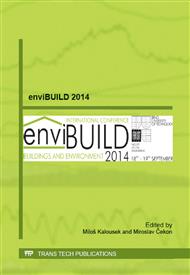p.96
p.105
p.109
p.113
p.117
p.121
p.125
p.129
p.135
Behavior of Point Thermal Bridges from Mechanical Anchoring of Flat Roofs
Abstract:
Building of structures with high energy performance is topical. To achieve this, it is necessary to have processed besides other thing a detailed design. Thermal bridges have to be eliminated in the design period. Thermal bridges occur as point, linear and 3-dimmensional ones. Mechanical anchoring creates point thermal bridges too. In this paper will be described only the mechanical anchoring to stabilize a flat roof. In the space with anchoring elements there is increased the thermal flux. This flux depends on the composition of the flat roof and kind of anchoring elements. It could lead to the condensation of water vapour in these locations upon attainment of the critical value of surface temperature in the room. This issue has another not-less interesting side. It is behaviour in summer season, when the anchoring conducts heat to the interior of objects. These thermal bridges caused by the anchoring elements described in this article will be modelled with the Ansys software tool.
Info:
Periodical:
Pages:
117-120
Citation:
Online since:
October 2014
Authors:
Keywords:
Price:
Сopyright:
© 2014 Trans Tech Publications Ltd. All Rights Reserved
Share:
Citation:


